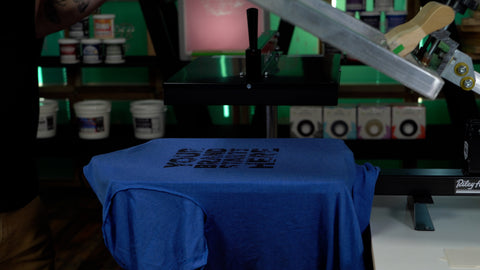When dyeing a garment, two methods exist — pigment dyeing and traditional garment dyeing. These two processes create different dyes in a garment. Both are great options for screen printers. So what’s the big difference? Let’s jump in and find out.

PIGMENT DYEING
When a garment is dyed with pigment, the pigments are generally added once the garment has been cut and sewn. A chemical bonding agent needs to be added to the shirt fabric for the pigment to adhere properly. Pigment-dyed apparel is soft and stylish, having become more popular in recent years.
Pigment dyes tend to wear away with repeated washing. While many pigments can be found in nature, the modern pigment-dyeing method uses synthetic materials. These pigments can come in any color of the rainbow.
A pigment-dyed garment goes through a few different steps in the dyeing process. First, it enters a cationic pre-treatment rinse and an acid wash to make the shirt extra soft. After that, pigment is applied along with the chemical binding agent. The garment gets rinsed again and tumble-dried to cure the binding agent and pigment to the shirt. A final enzyme is applied to remove any extra dye particles, and then the shirt is dried one last time.
RELATED: 20+ T-SHIRT TERMS EVERY SCREEN PRINTER SHOULD KNOW
TAKING CARE OF PIGMENT-DYED SHIRTS
Since pigment-dyed shirts wear out eventually, caring for them is important. Wash these types of garments in cold water, and keep them with like colors (or completely separate if you can). Don’t use stain removers, as this can fade the dye or strip the color of the garment, depending on the product you’re using.
Air-drying pigment-dyed garments is the best way to prevent color loss and fading. If air-drying isn't an option, tumble dry on low.
BEST PRACTICES FOR PRINTING
The color in pigment-dyed shirts essentially sits on top of the fabric. If you were to turn the shirt inside out, you wouldn’t see the same color on the inside of the garment as the outside. Because the pigment is applied with a binder, it’s likely that some color may be displaced, creating a weathered look. These pigments can also transfer to other materials if they haven’t been properly cured.
Pigment-dyed fabrics look about 10% less colorful than a garment dyed in the traditional way will. It’s a weathered, softer shade of color. These shirts are reasonably priced, but can experience dye migration (more on that later). Choosing a pigment-dyed shirt can lower the cost because it is one less step in the manufacturing process.
RELATED: BEST PRACTICES FOR TAKING CARE OF PRINTED T-SHIRTS

TRADITIONAL GARMENT DYEING
Look in a box of shirts, and you’ll see they’re the same color inside and out. Traditional garment dyeing is done by dyeing the shirts after they’re cut and sewn together. Dyeing the fabric this way before cutting and sewing can create discoloration. You may see a heavier concentration around the seams and neckline of the garment.
To dye shirts using the traditional process, raw dye is mixed with water, and then the garment is dipped into the mixture to color the entire piece. The process is different than pigment dyeing and creates a more vibrant color.
TAKING CARE OF GARMENT-DYED SHIRTS
Caring for traditionally-dyed garments is similar to pigment-dyed shirts. Wash the garment in cool water to prevent the color from running onto other materials. Treat a new shirt the way you would a new pair of jeans.
After a while, the color bleeding from the shirt will be minimal or stop altogether. Once no more color bleeds from the shirt, wash it with like colors at a cool temperature. Like pigment-dyed garments, it’s best to air-dry your shirts, but they can be tumbled dry on a low setting.
Garment-dyed shirts are more likely to bleed during a wash cycle because the dye is water-soluble. It’s a slightly more expensive method of adding color to a t-shirt.
RELATED: THE 4 MOST COMMON TYPES OF T-SHIRTS FOR SCREEN PRINTING

HOW CAN I TELL WHICH DYE IS USED?
The best way to tell if a garment has been dyed with pigment or traditional dye is to cut into the fabric. Since pigment sits on top of the fabric instead of soaking in, the inside fibers of the garment won’t have any color. Pigment dye also typically has a softer feel.
When searching for blanks, the term “garment-dyed” or “pigment-dyed” will be written in either the shirt’s name or in the description. Searching “garment-dyed blue t-shirt blanks” is a good way to start looking for garments. Simply find the brand and fit you like and search for those important words: either “garment-dyed” or “pigment-dyed.”
WHY DOES IT MATTER?
Different types of dyes might seem like a life-changing decision for printers choosing shirts. However, the only real difference is the ink you’ll need to use. When printing on pigment-dyed garments, use low-bleed, poly white, or low-bleed low-cure ink. Don’t have those inks? You can use a dye blocker base underneath the print to stop dye migration.
One issue that printers can see is overdyeing. This doesn’t mean the garment was dyed too much. It means that the original shirt color was dyed to create a shirt of a different color, like a red shirt dyed black. Overdyed garments can cause trouble for printers using discharge ink. The shirt will show the original garment color that may not be dischargeable.
Make sure to look into the type of shirts you’re purchasing to make sure they work with your print process. Having the right inks on hand will help the print job go smoothly.
RELATED: WHAT IS DYE MIGRATION AND HOW DOES IT AFFECT MY PRINTS?

Ultimately, the dyeing process of a shirt matters most to your customers and your budget. Pigment-dyed garments are a little more price-friendly, but each dye method has its pros and cons. Don’t know which method you like? Try both out and see what works best for your shop.

